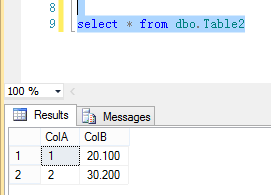The merge _update_ clause specifies the new column values of the target table. If the update clause is execute then all update triggers defined on the target table are activated. It’s a bit smarter than an INSERT INTO SELECT statement. Want to add some conditions in MERGE statement in oracle sql for. Below are just four simple ways you can use output clause with the merge statement.
In my program,for new record do insert and existing recordo nothing. Oracle sql merge to insert and. The WITH clause may be processed as an inline view or resolved as a temporary table.
You can specify the DELETE where_ clause to clean up data in a table while the MERGE statement is populating or updating it. The only rows affected by the delete clause of the MERGE statement are those rows in the target table that are updated by the merge operation. The MERGE statement is used to make changes in one table based on values matched from anther. It can be used to combine insert, update, and delete operations into one statement.

In this article, we’ll explore how to use the MERGE statement. As we have already learned INSERT INTO and UPDATE statement , our next very important statement is MERGE. Merge statement helps to perform insert, update and delete operations in one single statement.
Replace the MERGE statement with an insert or an update statement. A second table is created with updated item and price information. In order to roll all the info into the original catalogtable, merge is use since this is a standard UPDATE-else-INSERT task. We can also use the SQL -WITH clause instead of temporary tables. The SQL -WITH clause is very confusing at first because the SQL statement does not begin with the word SELECT.
If I read it correctly basically what it is saying that if you try to use filtering in the ON clause (which can be tricky even in a SELECT statement ) that you may incorrectly push rows out of the WHEN MATCHED clause and into one of the WHEN NOT MATCHED clauses. This article introduces the new MERGE SQL command (sometimes referred to as UPSERT). I hadn’t thought of that.
MERGE is a DML command that enables us to optionally update or insert data into a target table, depending on whether matching records already exist. The MERGE syntax just takes a bit of explaining, and Rob Sheldon is, as always, on hand to explain with plenty of examples. Note: Primarily of value when moving large amounts of data in data. We have to update the Mobiles table based on the Mobiles_New table so that: 1. Mobiles that exist in both the Mobiles_New table and the Mobiles table are updated in the Mobiles table with new names.
There is no WHERE in that part of the MERGE statement. See MERGE (Transact- SQL ) in the documentation for syntax help. The merge _update_ clause and merge _insert_ clause became optional. This means that it must occur in the WHEN MATCHED THEN clause.
The MERGE command in SQL is actually a combination of three SQL statements: INSERT, UPDATE and DELETE. In simple words, the MERGE statement in SQL provides a convenient way to perform all these three operations together which can be very helpful when it comes to handle the large running databases. Use the MERGE statement to select rows from one table for update or insertion into another table. The decision whether to update or insert into the target table is based on a condition in the ON clause. It is also known as UPSERT i. You cannot update a Target row multiple times with a MERGE statement Implementations.

Some also add non-standard SQL extensions. The DELETE clause of the MERGE statement will only ever act on records that were MATCHED and updated. PLSQL is closely integrated into the SQL language, yet it adds programming constructs that are not native to SQL. Statement Level triggers: Insert, Update, Delete.
Not only does the MERGE statement support the UPSERT concept, but it will also support deleting records. Но выделенная желтым clause второго merge не отображается в плане. Trigger, die für dieselbe Aktion definiert sin halten sich an die von Ihnen angegebene Reihenfolge.
Where clause in SQL MERGE UPDATE statement. Hi, Thanks for the reply. Here the MERGE statement only performed UPDATE statements. If you look at my MERGE statement I arranged the WHEN clause to have the UPDATE statement as the last set of actions to be taken. However, you can see that my MERGE statement did not perform the actions in the order they where specified in the MERGE statement.
The where clause in DELETE must refer to a column in the target table, not the source table. DELETE can only occur in the “WHEN MATCHED THEN” clause of the MERGE statement. Refine the ON clause to ensure a target row matches at most one source row, or use the GROUP BY clause to group the source rows.
Keine Kommentare:
Kommentar veröffentlichen
Hinweis: Nur ein Mitglied dieses Blogs kann Kommentare posten.